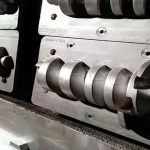The polishing mentioned in the plastic mold processing is very different from the surface polishing required in other industries. Strictly speaking, the polishing of the mold should be called mirror processing. It not only has high requirements for polishing itself, but also has high standards for surface flatness, smoothness and geometric accuracy. Surface polishing generally only requires a bright surface. The standards for mirror processing are divided into four levels:
Because it is difficult to accurately control the geometric accuracy of parts by methods such as electrolytic polishing and fluid polishing, and the surface quality of the methods such as chemical polishing, ultrasonic polishing, and magnetic abrasive polishing cannot meet the requirements, the mirror surface processing of precision molds is still mainly mechanical polishing. .
1. Semi-precision polishing mainly uses sandpaper and kerosene.
The number of sandpaper is: #400-#600-#800-#1000-#1200-#1500. In fact, #1500 sandpaper is only suitable for hardened die steel (above 52HRC), not for pre-hardened steel, because it may cause burns on the surface of pre-hardened steel.
2. Fine polishing mainly uses diamond grinding paste.
If the usual grinding order is 9um(#1800)-6um(#3000)-um(8000). 9um diamond abrasive paste and polishing cloth wheel can be used to remove the hair-like wear marks left by #1200 and #1500 sandpaper. Then use sticky felt and diamond paste for polishing, the order is 1um (#14000)-1/2um (60000)-1/4um (#100000).
The polishing process of the precision requirement above 1um (including the number 1um) must be an absolutely clean space in the polishing of the mold. Dust, smoke, dandruff and saliva can all scrap the high-precision polished surface obtained after several hours of work.
3.The basic procedure of mechanical polishing
To obtain high-quality polishing results, the most important thing is to have high-quality polishing tools and auxiliary products such as oilstone, sandpaper and abrasive paste. The most important thing is a polished working environment, which requires a dust-free workshop. The choice of polishing procedure depends on the surface condition of the pre-processing, such as machining, EDM, grinding and so on.
4.The general process of mechanical polishing
The surface after rough polishing, fine milling, electric spark, grinding and other processes can be polished by a rotating surface polishing machine or an ultrasonic grinder with a speed of 35000-40000rpm. The commonly used method is to use a diameter of 3mm, WA#400 wheels to remove the white electric spark layer. Then there is manual whetstone grinding, and the strips of emery whetstone are added with kerosene as a lubricant or coolant. The general order of use is #180-#240-#400-#600-#1000. Many mold manufacturers choose to start with #400 in order to save time.
Mold Wiki provides you with the most comprehensive plastic, plastic, mold, mold design, decoration knowledge points of plastic mold brands, and shopping guide and online shopping services for various plastic molds, with the cheapest plastic mold prices and the best quality after-sales service. Please visit Mold Wiki: https://mold.wiki/Keywords of the article: mold; mold-related products:
Link to this article:What are the mold polishing steps
Reprint Statement: If there are no special instructions, all articles on this site are original. Please indicate the source for reprinting:Mold Wiki,Thanks!^^

